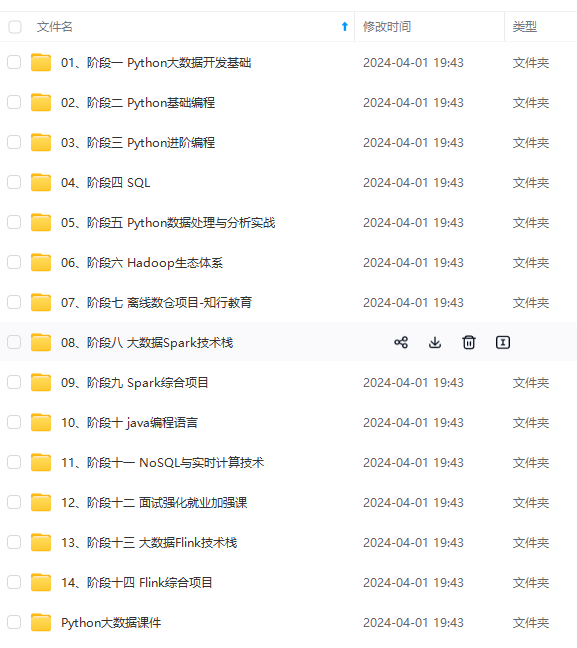

网上学习资料一大堆,但如果学到的知识不成体系,遇到问题时只是浅尝辄止,不再深入研究,那么很难做到真正的技术提升。
一个人可以走的很快,但一群人才能走的更远!不论你是正从事IT行业的老鸟或是对IT行业感兴趣的新人,都欢迎加入我们的的圈子(技术交流、学习资源、职场吐槽、大厂内推、面试辅导),让我们一起学习成长!
channel.basicQos(1);//每一次只能消费一个消息
channel.queueDeclare("hello",true,false,false,null);
channel.basicConsume("hello", false,new DefaultConsumer(channel) {
@SneakyThrows
@Override
public void handleDelivery(String consumerTag, Envelope envelope, AMQP.BasicProperties properties, byte[] body) throws IOException {
TimeUnit.SECONDS.sleep(1);
System.out.println(new String(body));
//参数1:手动确认消息标识 参数2:false 每次确认一个
channel.basicAck(envelope.getDeliveryTag(),false);
}
});
}
}
**消费者2**
public class Consumer_2 {
public static void main(String[] args) throws Exception {
Connection connection = RabbitMQUtils.getConnection();
Channel channel = connection.createChannel();
channel.queueDeclare(“hello”, true, false, false, null);
channel.basicQos(1);
channel.basicConsume(“hello”, false, new DefaultConsumer(channel) {
@Override
public void handleDelivery(String consumerTag, Envelope envelope, AMQP.BasicProperties properties, byte[] body) throws IOException {
System.out.println(new String(body));
//参数1:手动确认消息标识 参数2:false 每次确认一个
channel.basicAck(envelope.getDeliveryTag(), false);
}
});
}
}
消费者1输出
hello world-0
消费者2输出
hello world-1
hello world-2
hello world-3
hello world-4
hello world-5
hello world-6
hello world-7
hello world-8
hello world-9
上面的结果因为消费者1,加了延时1秒,且channel.basicQos(1); 每次接收接收一条消息,直到确认返回,所以其他就被消费者2没加延迟消费完了,能者多劳
### 3.4第三种模式-Publish/Subscribe/发布订阅(交换机-fanout类型)

>
> 在广播模式下,消息发送流程是这样的:
> 可以有多个消费者
> 每个消费者有自己的queue(队列)
> 每个队列都要绑定到Exchange(交换机)
> 生产者发送的消息,只能发送到交换机,
> 交换机来决定要发给哪个队列,生产者无法决定。
> 交换机把消息发送给绑定过的所有队列
> 队列的消费者都能拿到消息。实现一条消息被多个消费者消费
>
>
>
**生产者**
public class Producer {
public static void main(String[] args) throws Exception {
Connection connection = RabbitMQUtils.getConnection();
Channel channel = connection.createChannel();
//将通道声明指定交换机
//参数1: 交换机名称 参数2: 交换机类型 fanout 广播类型
channel.exchangeDeclare("logs", BuiltinExchangeType.FANOUT);
//发消息
channel.basicPublish("logs","",null,"fanout type message".getBytes());
RabbitMQUtils.closeConnectionAndChanel(channel,connection);
}
}
**消费者1**
public class Consumer_1 {
public static void main(String[] args) throws Exception {
Connection connection = RabbitMQUtils.getConnection();
Channel channel = connection.createChannel();
//通道绑定交换机
channel.exchangeDeclare(“logs”, “fanout”);
//获取临时队列名
String queueName = channel.queueDeclare().getQueue();
System.out.println(“queueName:” + queueName);
//绑定交换机和队列
channel.queueBind(queueName, “logs”, “”);
//自动确认关掉
channel.basicConsume(queueName, true, new DefaultConsumer(channel) {
@SneakyThrows
@Override
public void handleDelivery(String consumerTag, Envelope envelope, AMQP.BasicProperties properties, byte[] body) throws IOException {
System.out.println(“消费者1” + new String(body));
}
});
}
}
**消费者2**
public class Consumer_2 {
public static void main(String[] args) throws Exception {
Connection connection = RabbitMQUtils.getConnection();
Channel channel = connection.createChannel();
//通道绑定交换机
channel.exchangeDeclare(“logs”, “fanout”);
//获取临时队列名
String queueName = channel.queueDeclare().getQueue();
System.out.println(“queueName:” + queueName);
//绑定交换机和队列
channel.queueBind(queueName, “logs”, “”);
//自动确认关掉
channel.basicConsume(queueName, true, new DefaultConsumer(channel) {
@SneakyThrows
@Override
public void handleDelivery(String consumerTag, Envelope envelope, AMQP.BasicProperties properties, byte[] body) throws IOException {
System.out.println(“消费者2” + new String(body));
}
});
}
}
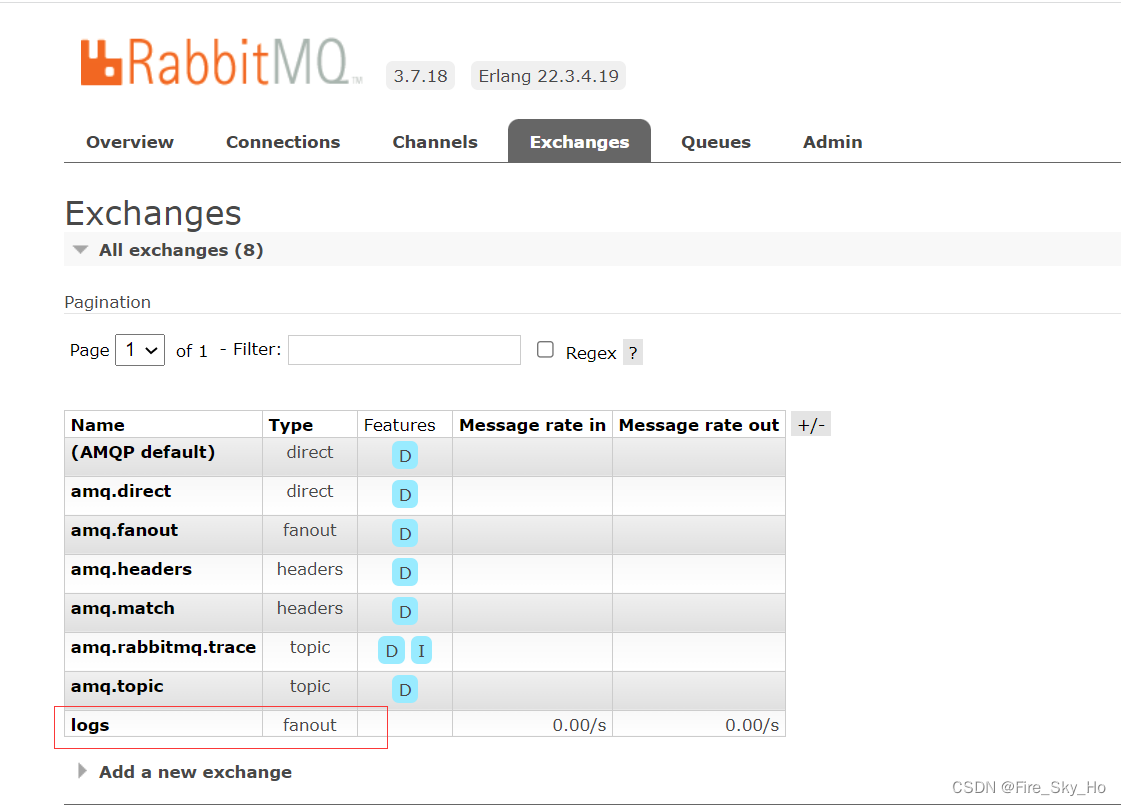
生产者启动,发布消息
两个消费者收到消息
消费者1fanout type message
消费者2fanout type message
### 3.5第四种模式-Routing/路由(交换机-Direct类型)
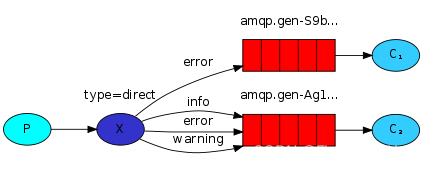
P:生产者,向Exchange发送消息,发送消息时,
会指定一个routing key。
X:Exchange(交换机),接收生产者的消息,
然后把消息递交给 与routing key完全匹配的队列
C1:消费者,其所在队列指定了需要routing key 为 error 的消息
C2:消费者,其所在队列指定了需要routing key 为 info、
error、warning 的消息
>
> 在Fanout模式中,一条消息,会被所有订阅的队列都消费。
> 但是,在某些场景下,我们希望不同的消息被不同的队列消费。
> 这时就要用到Direct类型的Exchange。
>
>
>
>
> 在Direct模型下:队列与交换机的绑定,不能是任意绑定了,
> 而是要指定一个RoutingKey(路由key)
> 消息的发送方在 向 Exchange发送消息时,
> 也必须指定消息的 RoutingKey。
> Exchange不再把消息交给每一个绑定的队列,
> 而是根据消息的Routing Key进行判断,
> 只有队列的Routingkey与消息的 Routing key完全一致,
> 才会接收到消息
>
>
>
**生产者**
public class Producer {
public static void main(String[] args) throws Exception {
Connection connection = RabbitMQUtils.getConnection();
Channel channel = connection.createChannel();
String exchangeName = "logs\_direct";
//将通道声明指定交换机
//参数1: 交换机名称 参数2: 交换机类型 fanout 广播类型
channel.exchangeDeclare(exchangeName, BuiltinExchangeType.DIRECT);
String routingKey = "info";
// String routingKey = “error”;
//发消息
channel.basicPublish(exchangeName, routingKey, null, (“这是direct模型发布的基于route key: [” + routingKey + “] 发送的消息”).getBytes());
RabbitMQUtils.closeConnectionAndChanel(channel, connection);
}
}
**消费者1**
public class Consumer_1 {
public static void main(String[] args) throws Exception {
Connection connection = RabbitMQUtils.getConnection();
Channel channel = connection.createChannel();
String exchangeName = “logs_direct”;
//通道绑定交换机
channel.exchangeDeclare(exchangeName, BuiltinExchangeType.DIRECT);
//获取临时队列名
String queueName = channel.queueDeclare().getQueue();
String routingKey = "error";
//绑定交换机和队列
channel.queueBind(queueName, exchangeName, routingKey);
//自动确认关掉
channel.basicConsume(queueName, true, new DefaultConsumer(channel) {
@SneakyThrows
@Override
public void handleDelivery(String consumerTag, Envelope envelope, AMQP.BasicProperties properties, byte[] body) throws IOException {
System.out.println("消费者1" + new String(body));
}
});
}
}
**消费者2**
public class Consumer_2 {
public static void main(String[] args) throws Exception {
Connection connection = RabbitMQUtils.getConnection();
Channel channel = connection.createChannel();
String exchangeName = “logs_direct”;
//通道绑定交换机
channel.exchangeDeclare(exchangeName, BuiltinExchangeType.DIRECT);
//获取临时队列名
String queueName = channel.queueDeclare().getQueue();
//绑定交换机和队列
//临时队列和交换机绑定
channel.queueBind(queueName, exchangeName, "info");
channel.queueBind(queueName, exchangeName, "error");
channel.queueBind(queueName, exchangeName, "warning");
//自动确认关掉
channel.basicConsume(queueName, true, new DefaultConsumer(channel) {
@SneakyThrows
@Override
public void handleDelivery(String consumerTag, Envelope envelope, AMQP.BasicProperties properties, byte[] body) throws IOException {
System.out.println("消费者2" + new String(body));
}
});
}
}
消费者1接收routingKey为error的消息,消费者2接收info,error,warning三种routingKey
首先启动生产者,routingKey为info,此时消费者2能收到消息
消费者2这是direct模型发布的基于route key: [info] 发送的消息
生产者,routingKey为error,消费者1和2都能收到消息
消费者1这是direct模型发布的基于route key: [error] 发送的消息
消费者2这是direct模型发布的基于route key: [error] 发送的消息
### 3.6第五种模式-Topic/主题(交换机-topic类型)
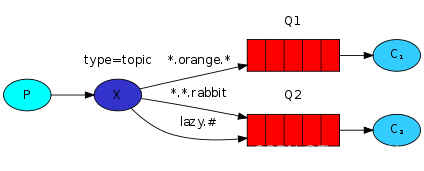
>
> Topic类型的Exchange与Direct相比,都是可以根据RoutingKey
> 把消息路由到不同的队列。只不过Topic类型Exchange可以让
> 队列在绑定Routing key的时候使用通配符!这种模型Routingkey
> 一般都是由一个或多个单词组成,多个单词之间以”.”分割,
> 例如: item.insert
>
>
>
>
> 在Direct模型下:队列与交换机的绑定,不能是任意绑定了,
> 而是要指定一个RoutingKey(路由key)
> 消息的发送方在 向 Exchange发送消息时,
> 也必须指定消息的 RoutingKey。
> Exchange不再把消息交给每一个绑定的队列,
> 而是根据消息的Routing Key进行判断,
> 只有队列的Routingkey与消息的 Routing key完全一致,
> 才会接收到消息
>
>
>
P:生产者,向Exchange发送消息,发送消息时,
会指定一个routing key。
X:Exchange(交换机),接收生产者的消息,
然后把消息递交给 与routing key完全匹配的队列
C1:消费者,其所在队列指定了需要routing key 为 error 的消息
C2:消费者,其所在队列指定了需要routing key 为 info、
error、warning 的消息
**生产者**
public class Producer {
public static void main(String[] args) throws Exception {
Connection connection = RabbitMQUtils.getConnection();
Channel channel = connection.createChannel();
String exchangeName = "topics";
//将通道声明指定交换机
//参数1: 交换机名称 参数2: 交换机类型 TOPIC 主题类型
channel.exchangeDeclare(exchangeName, BuiltinExchangeType.TOPIC);
String routingKey = "user.save";
//发消息
channel.basicPublish(exchangeName, routingKey, null, ("这是topic模型发布的基于route key: [" + routingKey + "] 发送的消息").getBytes());
channel.basicPublish(exchangeName, "a.pp", null, ("这是topic模型发布的基于route key: [" + "a.pp" + "] 发送的消息").getBytes());
RabbitMQUtils.closeConnectionAndChanel(channel, connection);
}
}
**消费者1**
public class Consumer_1 {
public static void main(String[] args) throws Exception {
Connection connection = RabbitMQUtils.getConnection();
Channel channel = connection.createChannel();
String exchangeName = “topics”;
//通道绑定交换机
channel.exchangeDeclare(exchangeName, BuiltinExchangeType.TOPIC);
//获取临时队列名
String queueName = channel.queueDeclare().getQueue();
String routingKey = "user.\*";
//绑定交换机和队列
channel.queueBind(queueName, exchangeName, routingKey);
//自动确认关掉
channel.basicConsume(queueName, true, new DefaultConsumer(channel) {
@SneakyThrows
@Override
public void handleDelivery(String consumerTag, Envelope envelope, AMQP.BasicProperties properties, byte[] body) throws IOException {
System.out.println("消费者1" + new String(body));
}
});
}
}
**消费者2**
public class Consumer_2 {
public static void main(String[] args) throws Exception {
Connection connection = RabbitMQUtils.getConnection();
Channel channel = connection.createChannel();
String exchangeName = “topics”;
//通道绑定交换机
channel.exchangeDeclare(exchangeName, BuiltinExchangeType.TOPIC);
//获取临时队列名
String queueName = channel.queueDeclare().getQueue();
String routingKey = "a.\*";
//绑定交换机和队列
channel.queueBind(queueName, exchangeName, routingKey);
//自动确认关掉
channel.basicConsume(queueName, true, new DefaultConsumer(channel) {
@SneakyThrows
@Override
public void handleDelivery(String consumerTag, Envelope envelope, AMQP.BasicProperties properties, byte[] body) throws IOException {
System.out.println("消费者2" + new String(body));
}
});
}
}
生产者发布了routingKey为user.save和a.pp的消息
消费者1使用routingKey 通配符 user.\*接收,所以收到了以下消息
消费者1这是topic模型发布的基于route key: [user.save] 发送的消息
消费者2使用routingKey 通配符 a.\*接收,所以收到了以下消息
消费者2这是topic模型发布的基于route key: [a.pp] 发送的消息
## 4.SpringBoot中使用RabbitMQ
### 4.1 环境搭建
**pom**
4.0.0
com.example
springboot-rabbitmq
0.0.1-SNAPSHOT
springboot-rabbitmq
springboot-rabbitmq
<java.version>1.8</java.version>
<project.build.sourceEncoding>UTF-8</project.build.sourceEncoding>
<project.reporting.outputEncoding>UTF-8</project.reporting.outputEncoding>
<spring-boot.version>2.4.2</spring-boot.version>
org.springframework.boot
spring-boot-starter-web
org.springframework.boot
spring-boot-starter-test
test
org.springframework.boot
spring-boot-starter-amqp
org.springframework.boot
spring-boot-dependencies
${spring-boot.version}
pom
import
**yml**
spring:
application:
name: springboot_rabbitmq
rabbitmq:
host: 127.0.0.1
port: 5673
username: root
password: 123
virtual-host: /
### 4.1第一种-Hello World!/基础队列(生产者-队列-消费者)
**生产者**
@SpringBootTest
public class Producer {
@Autowired
private RabbitTemplate rabbitTemplate;
/\*\*
* 生产端没有指定交换机只有routingKey和Object。
* 消费方产生hello队列,放在默认的交换机(AMQP default)上。
* 而默认的交换机有一个特点,只要你的routerKey的名字与这个
* 交换机的队列有相同的名字,他就会自动路由上。
* 生产端routingKey 叫hello ,消费端生产hello队列。
* 他们就路由上了
*/
@Test
void producer() {
rabbitTemplate.convertAndSend(“hello”, “hello world”);
}
}
**消费者**
[Spring Boot中@RabbitHandler注解的介绍、原理和使用]( )
/**
* 生产端没有指定交换机只有routingKey和Object。
* 消费方产生hello队列,放在默认的交换机(AMQP default)上。
* 而默认的交换机有一个特点,只要你的routerKey的名字与这个
* 交换机的队列有相同的名字,他就会自动路由上。
* 生产端routingKey 叫hello ,消费端生产hello队列。
* 他们就路由上了
*/
@Component
@RabbitListener(queuesToDeclare = @Queue(value = “hello”))
public class ConsumerHelloWord {
@RabbitHandler
public void receive(String message) {
System.out.println("message = " + message);
}
}
先运行消费者,在运行生产者
### 4.2第二种-Work Queues/工作队列/任务队列
**生产者**
/**
* 生产端没有指定交换机只有routingKey和Object。
* 消费方产生work队列,放在默认的交换机(AMQP default)上。
* 而默认的交换机有一个特点,只要你的routerKey的名字与这个
* 交换机的队列有相同的名字,他就会自动路由上。
* 生产端routingKey 叫work ,消费端生产work队列。
* 他们就路由上了
*/
@Component
public class ConsumerWorkQueues {
@RabbitListener(queuesToDeclare = @Queue("work"))
public void receive1(String message) {
System.out.println("work message1 = " + message);
}
@RabbitListener(queuesToDeclare = @Queue("work"))
public void receive2(String message) {
System.out.println("work message2 = " + message);
}
}
**消费者**
/**
* 生产端没有指定交换机只有routingKey和Object。
* 消费方产生work队列,放在默认的交换机(AMQP default)上。
* 而默认的交换机有一个特点,只要你的routerKey的名字与这个
* 交换机的队列有相同的名字,他就会自动路由上。
* 生产端routingKey 叫work ,消费端生产work队列。
* 他们就路由上了
*/
@Component
public class ConsumerWorkQueues {
@RabbitListener(queuesToDeclare = @Queue("work"))
public void receive1(String message) {
System.out.println("work message1 = " + message);
}
@RabbitListener(queuesToDeclare = @Queue("work"))
public void receive2(String message) {
System.out.println("work message2 = " + message);
}
}
### 4.3第三种模式-Publish/Subscribe/发布订阅(交换机-fanout类型)
**生产者**
@SpringBootTest
public class Producer {
@Autowired
private RabbitTemplate rabbitTemplate;
@Test
void producer() {
for (int i = 0; i < 10; i++) {
//参数1为交换机
//参数2为路由key,“”表示为任意路由
//参数3为消息内容
rabbitTemplate.convertAndSend("logs","","这是日志广播");
}
}
}
**消费者**
@Component
public class ConsumerWorkQueuesFanout {
//使用@RabbitListener注解中的bindings声明并绑定交换机和队列
@RabbitListener(bindings = @QueueBinding(value = @Queue, // 创建临时队列
exchange = @Exchange(name = "logs", type = ExchangeTypes.FANOUT)
))
public void receive1(String message) {
System.out.println("message1 = " + message);
}
@RabbitListener(bindings = @QueueBinding(value = @Queue, // 创建临时队列
exchange = @Exchange(name = "logs", type = ExchangeTypes.FANOUT)
))
public void receive2(String message) {
System.out.println("message2 = " + message);
}
}
### 4.4第四种模式-Routing/路由(交换机-Direct类型)
**生产者**
@SpringBootTest
public class Producer {
@Autowired
private RabbitTemplate rabbitTemplate;
@Test
void producer() {
for (int i = 0; i < 10; i++) {
//参数1为交换机
//参数2为路由key,“”表示为任意路由
//参数3为消息内容
rabbitTemplate.convertAndSend("directs","error","error 的日志信息");
}
}
}
**消费者**
@Component
public class ConsumerRouting {
//使用@RabbitListener注解中的bindings声明并绑定交换机和队列
@RabbitListener(bindings = @QueueBinding(value = @Queue("directsQueue"),//指定队列名
key = {"info", "error"},
exchange = @Exchange(name = "directs", type = ExchangeTypes.DIRECT)
))
public void receive1(String message) {
System.out.println("message1 = " + message);
}
@RabbitListener(bindings = @QueueBinding(value = @Queue("directsQueue"),
key = {"error"},
exchange = @Exchange(name = "directs", type = ExchangeTypes.DIRECT)
))
public void receive2(String message) {
System.out.println("message2 = " + message);
}
}
### 4.5第五种模式-Topic/主题(交换机-topic类型)
**生产者**
@SpringBootTest
public class Producer {
@Autowired
private RabbitTemplate rabbitTemplate;
@Test
void producer() {
for (int i = 0; i < 10; i++) {
//参数1为交换机
//参数2为路由key,“”表示为任意路由
//参数3为消息内容
rabbitTemplate.convertAndSend("topics","user.save.findAll","user.save.findAll 的消息");
}
}
}
**消费者**
@Component
public class ConsumerTopics {
@RabbitListener(bindings = {
@QueueBinding(
value = @Queue,
key = {"user.\*"},
exchange = @Exchange(type = ExchangeTypes.TOPIC, name = "topics")
)
})
public void receive1(String message) {
System.out.println("message1 = " + message);
}
@RabbitListener(bindings = {
@QueueBinding(
value = @Queue,
key = {"user.#"},
exchange = @Exchange(type = ExchangeTypes.TOPIC, name = "topics")
)
})
public void receive2(String message) {
System.out.println("message2 = " + message);
}
}
## 5.死信队列,延迟队列
### 5.1 死信概念
>
> 先从概念解释上搞清楚这个定义,死信,顾名思义就是无法被消费的消息,字面意思可以这样理解,一般来说,producer 将消息投递到
> broker 或者直接到queue 里了,consumer 从 queue 取出消息进行消费,但某些时候由于特定的原因导致 queue
> 中的某些消息无法被消费,这样的消息如果没有 后续的处理,就变成了死信,有死信自然就有了死信队列。
>
>
>
>
> 应用场景:为了保证订单业务的消息数据不丢失,需要使用到
> RabbitMQ的死信队列机制,当消息消费发生异常时,将消息投入死信队列中.还有比如说:用户在商城下单成功并点击去支付后在指定时间未支付时自动失效
>
>
>
### 5.2死信的来源
1. 消息 TTL 过期
2. 队列达到最大长度(队列满了,无法再添加数据到 mq 中)
3. 消息被拒绝(basic.reject 或 basic.nack)并且 requeue=false.
### 5.3入门实战
#### 5.3.1 架构图

#### 5.3.2 代码
**生产者**
public class Producer {
private static final String NORMAL_EXCHANGE = “normal_exchange”;
public static void main(String[] argv) throws Exception {
try (Channel channel = RabbitMQUtils.getConnection().createChannel()) {
channel.exchangeDeclare(NORMAL\_EXCHANGE,
BuiltinExchangeType.DIRECT);
//设置消息的 TTL 时间
AMQP.BasicProperties properties = new AMQP.BasicProperties().builder().expiration("10000").build();
//该信息是用作演示队列个数限制
for (int i = 1; i < 11; i++) {
String message = "info" + i;
channel.basicPublish(NORMAL\_EXCHANGE, "zhangsan", properties, message.getBytes());
System.out.println("生产者发送消息:" + message);
}
}
}
}
**消费者1**
public class Consumer01 {
//普通交换机名称
private static final String NORMAL_EXCHANGE = “normal_exchange”;
//死信交换机名称
private static final String DEAD_EXCHANGE = “dead_exchange”;
public static void main(String[] argv) throws Exception {
Channel channel = RabbitMQUtils.getConnection().createChannel();
//声明死信和普通交换机 类型为 direct
channel.exchangeDeclare(NORMAL\_EXCHANGE, BuiltinExchangeType.DIRECT);
channel.exchangeDeclare(DEAD\_EXCHANGE, BuiltinExchangeType.DIRECT);
//声明死信队列
String deadQueue = "dead-queue";
channel.queueDeclare(deadQueue, false, false, false, null);
//死信队列绑定死信交换机与 routingKey
channel.queueBind(deadQueue, DEAD\_EXCHANGE, "lisi");
Map<String, Object> params = new HashMap<>();
//正常队列设置死信交换机 参数 key 是固定值
params.put("x-dead-letter-exchange", DEAD\_EXCHANGE);
//正常队列设置死信 routing-key 参数 key 是固定值
params.put("x-dead-letter-routing-key", "lisi");
String normalQueue = "normal-queue";
//正常队列绑定死信队列信息
channel.queueDeclare(normalQueue, false, false, false, params);
channel.queueBind(normalQueue, NORMAL\_EXCHANGE, "zhangsan");
System.out.println("等待接收消息........... ");
DeliverCallback deliverCallback = (consumerTag, delivery) ->
{
String message = new String(delivery.getBody(), StandardCharsets.UTF\_8);
System.out.println("Consumer01 接收到消息" + message);
};
channel.basicConsume(normalQueue, true, deliverCallback, consumerTag -> {
});
}
}
**消费者2**
public class Consumer02 {
//死信交换机名称
private static final String DEAD_EXCHANGE = “dead_exchange”;
public static void main(String[] argv) throws Exception {
Channel channel = RabbitMQUtils.getConnection().createChannel();
channel.exchangeDeclare(DEAD\_EXCHANGE, BuiltinExchangeType.DIRECT);
//声明死信队列
String deadQueue = "dead-queue";
channel.queueDeclare(deadQueue, false, false, false, null);
//死信队列绑定死信交换机与 routingKey
channel.queueBind(deadQueue, DEAD\_EXCHANGE, "lisi");
System.out.println("等待接收消息........... ");
DeliverCallback deliverCallback = (consumerTag, delivery) ->
{
String message = new String(delivery.getBody(), StandardCharsets.UTF\_8);
System.out.println("Consumer01 接收到消息" + message);
};
channel.basicConsume(deadQueue, true, deliverCallback, consumerTag -> {
});
}
}
**流程**
启动消费者1,生产交换机和队列


启动消费者,发现10条消息没被消费

等待10S后,发现没被消费就转移到死信队列

启动消费者2,消费者2去消费死信队列的消息

### 5.4 SpringBoot实现延迟队列
#### 5.4.1 延迟队列概念
延时队列,队列内部是有序的,最重要的特性就体现在它的延时属性上,延时队列中的元素是希望在指定时间到了以后或之前取出和处理,简单来说,延时队列就是用来存放需要在指定时间被处理的元素的队列。
#### 5.4.2 延迟队列使用场景
1.订单在十分钟之内未支付则自动取消
2.新创建的店铺,如果在十天内都没有上传过商品,则自动发送消息提醒。
3.用户注册成功后,如果三天内没有登陆则进行短信提醒。
4.用户发起退款,如果三天内没有得到处理则通知相关运营人员。
5.预定会议后,需要在预定的时间点前十分钟通知各个与会人员参加会议
这些场景都有一个特点,需要在某个事件发生之后或者之前的指定时间点完成某一项任务
#### 5.4.3 RabbitMQ 中的 TTL
TTL 是什么呢?TTL 是 RabbitMQ 中一个消息或者队列的属性,表明一条消息或者该队列中的所有消息的最大存活时间,单位是毫秒。
换句话说,如果一条消息设置了 TTL 属性或者进入了设置TTL 属性的队列,那么这条消息如果在TTL 设置的时间内没有被消费,则会成为"死信"。如果同时配置了队列的TTL 和消息的TTL,那么较小的那个值将会被使用,有两种方式设置 TTL。
如果设置了队列的 TTL 属性,那么一旦消息过期,就会被队列丢弃(如果配置了死信队列被丢到死信队 列中),而第二种方式,消息即使过期,也不一定会被马上丢弃,因为消息是否过期是在即将投递到消费者 之前判定的,如果当前队列有严重的消息积压情况,则已过期的消息也许还能存活较长时间;另外,还需 要注意的一点是,如果不设置 TTL,表示消息永远不会过期,如果将 TTL 设置为 0,则表示除非此时可以 直接投递该消息到消费者,否则该消息将会被丢弃。
前一小节我们介绍了死信队列,刚刚又介绍了 TTL,至此利用 RabbitMQ 实现延时队列的两大要素已 经集齐,接下来只需要将它们进行融合,再加入一点点调味料,延时队列就可以新鲜出炉了。想想看,延 时队列,不就是想要消息延迟多久被处理吗,TTL 则刚好能让消息在延迟多久之后成为死信,另一方面, 成为死信的消息都会被投递到死信队列里,这样只需要消费者一直消费死信队列里的消息就完事了,因为 里面的消息都是希望被立即处理的消息。
#### 5.4.3 架构图
创建两个队列 QA 和 QB,两者队列 TTL 分别设置为 10S 和 20S,然后在创建一个交换机 X 和死信交换机 Y,它们的类型都是direct,创建一个死信队列 QD,它们的绑定关系如下:

#### 5.4.4 实现代码
用上面的springboot项目继续搞这个延迟队列
**配置类** 用于生命交换机、队列以及之间的绑定关系
@Configuration
public class DeadQueueConfig {
public static final String EXCHANGE_X = “X”;
public static final String ROUTING_KEY_XA = “XA”;
public static final String ROUTING_KEY_XB = “XB”;
public static final String QUEUE_A = “QA”;
public static final String QUEUE_B = “QB”;
public static final String EXCHANGE_Y = “Y”;
public static final String QUEUE_D = “QD”;
public static final String ROUTING_KEY_YD = “YD”;
public static final int X_MESSAGE_TTL_QA = 10;
public static final int X_MESSAGE_TTL_QB = 20;
// 声明 交换机X
@Bean
public DirectExchange exchangeX() {
return new DirectExchange(EXCHANGE\_X);
}
//声明队列 A ttl 为 10s 并绑定到对应的死信交换机
@Bean
public Queue queueA() {
return QueueBuilder.durable(QUEUE\_A)
//声明当前队列绑定的死信交换机
.deadLetterExchange(EXCHANGE\_Y)
//声明当前队列的死信路由 key
.deadLetterRoutingKey(ROUTING\_KEY\_YD)
//声明队列的 TTL
.ttl(X\_MESSAGE\_TTL\_QA \* 1000)
.build();
}
// 声明队列 A 绑定 X 交换机
@Bean
public Binding queueABindExchangeX(Queue queueA, DirectExchange exchangeX) {
return BindingBuilder.bind(queueA).to(exchangeX).with(ROUTING\_KEY\_XA);
}
//声明队列 B ttl 为 20s 并绑定到对应的死信交换机
@Bean
public Queue queueB() {
return QueueBuilder.durable(QUEUE\_B)
.deadLetterExchange(EXCHANGE\_Y)
.deadLetterRoutingKey(ROUTING\_KEY\_YD)
.ttl(X\_MESSAGE\_TTL\_QB \* 1000)
.build();
}
//声明队列 B 绑定 X 交换机
@Bean
public Binding queueBBindExchangeX(Queue queueB, DirectExchange exchangeX) {
return BindingBuilder.bind(queueB).to(exchangeX).with(ROUTING\_KEY\_XB);
}
// 声明 交换机Y
@Bean
public DirectExchange exchangeY() {
return new DirectExchange(EXCHANGE\_Y);
}
//声明死信队列 QD
@Bean
public Queue queueD() {
return new Queue(QUEUE\_D);
}
//声明死信队列 QD 绑定关系
@Bean
public Binding queueDBindExchangeX(Queue queueD, DirectExchange exchangeY) {
return BindingBuilder.bind(queueD).to(exchangeY).with(ROUTING\_KEY\_YD);
}
}
**消费者**
@Slf4j
@Component
public class DeadLetterQueueConsumer {
@RabbitListener(queues = DeadQueueConfig.QUEUE\_D)
public void receiveD(Message message, Channel channel){
String msg = StrUtil.str(message.getBody(), StandardCharsets.UTF\_8);
log.info("当前时间:{},收到死信队列信息{}", DateUtil.now(), msg);
}
}
**生产者**
@Slf4j
@RequestMapping(“ttl”)
@RestController
public class SendMsgController {
@Autowired
private RabbitTemplate rabbitTemplate;
@GetMapping("sendMsg/{message}")
public void sendMsg(@PathVariable String message) {
log.info("当前时间:{},发送一条信息给两个 TTL 队列:{}", DateUtil.now(), message);
//第三个参数:要发送的消息
rabbitTemplate.convertAndSend(DeadQueueConfig.EXCHANGE\_X, DeadQueueConfig.ROUTING\_KEY\_XA, "消息来自 ttl 为 " + DeadQueueConfig.X\_MESSAGE\_TTL\_QA + "S 的队列: " + message);
rabbitTemplate.convertAndSend(DeadQueueConfig.EXCHANGE\_X, DeadQueueConfig.ROUTING\_KEY\_XB, "消息来自 ttl 为 " + DeadQueueConfig.X\_MESSAGE\_TTL\_QB + "S 的队列: " + message);
}
}
发送请求 [http://127.0.0.1:8080/ttl/sendMsg/姬霓太美]( )

第一条消息在 10S 后变成了死信消息,然后被消费者消费掉,第二条消息在 40S 之后变成了死信消息, 然后被消费掉,这样一个延时队列就打造完成了。
不过,如果这样使用的话,岂不是每增加一个新的时间需求,就要新增一个队列,这里只有 10S 和 40S 两个时间选项,如果需要一个小时后处理,那么就需要增加TTL 为一个小时的队列,如果是预定会议室然 后提前通知这样的场景,岂不是要增加无数个队列才能满足需求?
0
#### 5.4.5 优化,由生产者定义消息存活时间
##### 5.4.5.1 代码架构图
在这里新增了一个队列 QC,绑定关系如下,该队列不设置TTL 时间,有生产者设定消息ttl

##### 5.4.5.2 代码
**配置类新增**
//声明队列C,ttl为生产者设置,并绑定到对应的死信交换机
@Bean
public Queue queueC() {
return QueueBuilder.durable(QUEUE\_C)
//声明当前队列绑定的死信交换机
.deadLetterExchange(EXCHANGE\_Y)
//声明当前队列的死信路由 key
.deadLetterRoutingKey(ROUTING\_KEY\_YD)
.build();
}
//声明队列 QC 绑定关系
@Bean
public Binding queueCBindExchangeX(Queue queueC, DirectExchange exchangeX) {
return BindingBuilder.bind(queueC).to(exchangeX).with(ROUTING\_KEY\_XC);
}
**消费者新增**
@GetMapping("sendExpirationMsg/{message}/{ttlTimeMillisecond}")
public void sendMsg(@PathVariable String message, @PathVariable String ttlTimeMillisecond) {
rabbitTemplate.convertAndSend(DeadQueueConfig.EXCHANGE\_X, DeadQueueConfig.ROUTING\_KEY\_XC, message, correlationData -> {
correlationData.getMessageProperties().setExpiration(ttlTimeMillisecond);
return correlationData;
});
log.info("当前时间:{},发送一条时长{}秒 TTL 信息给队列 C:{}", DateUtil.now(), TimeUnit.MILLISECONDS.toSeconds(Long.parseLong(ttlTimeMillisecond)), message);
}
启动应用,按顺序请求以下接口
[http://127.0.0.1:8080/ttl/sendExpirationMsg/姬霓太美/2000]( )
[http://127.0.0.1:8080/ttl/sendExpirationMsg/姬霓太美/20000]( )
可以发现,正常消费,2秒后的消费了,20秒后的也消费了

此时看着正常,但是我们反顺序过来请求,先请求20秒的,在请求2秒的
[http://127.0.0.1:8080/ttl/sendExpirationMsg/姬霓太美/20000]( )
[http://127.0.0.1:8080/ttl/sendExpirationMsg/姬霓太美/2000]( )
结果如下,发现2秒的并没有先消费,而是消费完20秒的,再消费2秒的,因为mq底层就是FIFO,所以只能这样

**结论**
使用这种由生产者定义消息ttl的方式,如果第一个消息的延时时长很长,而第二个消息的延时时长很短,第二个消息并不会优先得到执行。
#### 5.4.6 Rabbitmq 插件实现延迟队列
上文中提到的问题,确实是一个问题,如果不能实现在消息粒度上的 TTL,并使其在设置的TTL 时间及时死亡,就无法设计成一个通用的延时队列。那如何解决呢,接下来我们就去解决该问题。
##### 5.4.6.1 安装延时队列插件
在官网上下载 <https://www.rabbitmq.com/community-plugins.html>,下载
[rabbitmq\_delayed\_message\_exchange]( ) 插件,注意对应当前mq版本,然后到 RabbitMQ 的插件目录。
可以使用搜索命令,查找插件目录
find / -name plugins
/usr/lib/rabbitmq/lib/rabbitmq_server-3.7.18/plugins
执行下面命令让该插件生效
rabbitmq-plugins enable rabbitmq_delayed_message_exchange

##### 5.4.6.2 代码架构图
在这里新增了一个队列delayed.queue,一个自定义交换机delayed.exchange,绑定关系如下:

##### 5.4.6.3 代码
在我们自定义的交换机中,这是一种新的交换类型,该类型消息支持延迟投递机制 消息传递后并不会立即投递到目标队列中,而是存储在 mnesia(一个分布式数据系统)表中,当达到投递时间时,才投递到目标队列中。
**配置类**
@Configuration
public class DelayedQueueConfig {
public static final String DELAYED_QUEUE_NAME = “delayed.queue”;
public static final String DELAYED_EXCHANGE_NAME = “delayed.exchange”;
public static final String DELAYED_ROUTING_KEY = “delayed.routingkey”;
@Bean
public Queue delayedQueue() {
return new Queue(DELAYED\_QUEUE\_NAME);
}
//自定义交换机 我们在这里定义的是一个延迟交换机
@Bean
public CustomExchange delayedExchange() {
Map<String, Object> args = new HashMap<>();
//自定义交换机的类型
args.put("x-delayed-type", ExchangeTypes.DIRECT);
return new CustomExchange(DELAYED\_EXCHANGE\_NAME, "x-delayed-message", true, false,
args);
}
@Bean
public Binding bindingDelayedQueue(Queue delayedQueue, CustomExchange delayedExchange) {
return BindingBuilder.bind(delayedQueue).to(delayedExchange).with(DELAYED\_ROUTING\_KEY).noargs();
}
}
**生产者**
@Slf4j
@RequestMapping(“ttl”)
@RestController
public class DelayedQueueProducerController {
@Autowired
private RabbitTemplate rabbitTemplate;
public static final String DELAYED\_EXCHANGE\_NAME = "delayed.exchange";
public static final String DELAYED\_ROUTING\_KEY = "delayed.routingkey";
@GetMapping("sendDelayMsg/{message}/{delayTime}")
public void sendMsg(@PathVariable String message, @PathVariable Integer delayTime) {
rabbitTemplate.convertAndSend(DELAYED\_EXCHANGE\_NAME, DELAYED\_ROUTING\_KEY, message,
correlationData -> {
correlationData.getMessageProperties().setDelay(delayTime);
return correlationData;
});
log.info(" 当 前 时 间 : {}, 发 送 一 条 延 迟 {} 秒的信息给队列 delayed.queue:{}", DateUtil.now(), TimeUnit.MILLISECONDS.toSeconds(delayTime), message);
}
}
**消费者**
@Slf4j
@Component
public class DelayedQueueConsumer {
public static final String DELAYED_QUEUE_NAME = “delayed.queue”;
@RabbitListener(queues = DELAYED\_QUEUE\_NAME)
public void receiveDelayedQueue(Message message) {
String msg = StrUtil.str(message.getBody(), StandardCharsets.UTF\_8);
log.info("当前时间:{},收到延时队列的消息:{}", DateUtil.now(), msg);
}
}
启动应用,分别访问
[http://localhost:8080/ttl/sendDelayMsg/come on baby1/20000]( )
[http://localhost:8080/ttl/sendDelayMsg/come on baby1/2000]( )
结果如下,20秒的先访问,2秒后访问,但是还是2秒快的先消费了

#### 5.4.7 总结
延时队列在需要延时处理的场景下非常有用,使用 RabbitMQ 来实现延时队列可以很好的利用 RabbitMQ 的特性,如:消息可靠发送、消息可靠投递、死信队列来保障消息至少被消费一次以及未被正 确处理的消息不会被丢弃。另外,通过 RabbitMQ 集群的特性,可以很好的解决单点故障问题,不会因为 单个节点挂掉导致延时队列不可用或者消息丢失。
当然,延时队列还有很多其它选择,比如利用 Java 的 DelayQueue,利用 Redis 的 zset,利用 Quartz 或者利用 kafka 的时间轮,这些方式各有特点,看需要适用的场景
## 6 发布确认高级
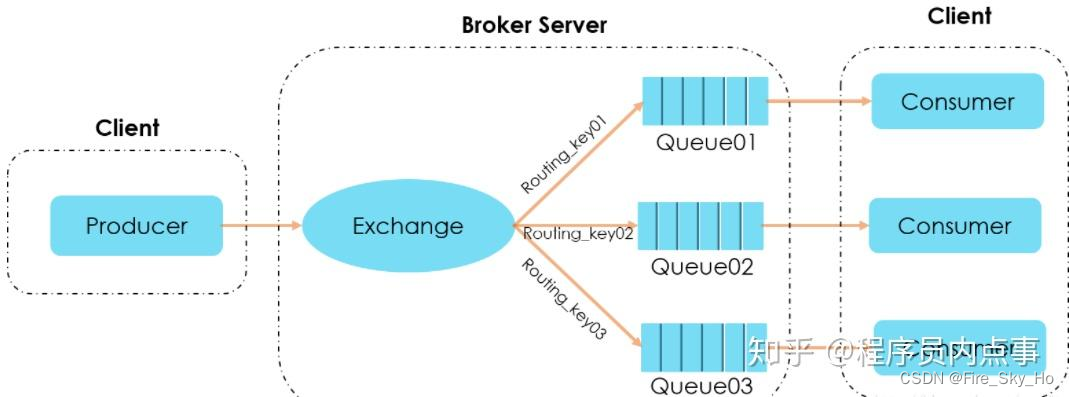
>
> [springboot + rabbitmq 消息确认机制(避坑指南)]( )
> 发送消息确认:用来确认生产者 producer 将消息发送到 broker ,broker 上的交换机 exchange 再投递给队列
> queue的过程中,消息是否成功投递。
>
>
> 消息从 producer 到 rabbitmq broker有一个 confirmCallback 确认模式。
>
>
> 消息从 exchange 到 queue 投递失败有一个 returnCallback 退回模式。
>
>
> 我们可以利用这两个Callback来确保消的100%送达。
>
>
>
在生产环境中由于一些不明原因,导致 rabbitmq 重启,在 RabbitMQ 重启期间生产者消息投递失败,
导致消息丢失,需要手动处理和恢复。于是,我们开始思考,如何才能进行 RabbitMQ 的消息可靠投递呢? 特
别是在这样比较极端的情况,RabbitMQ 集群不可用的时候,无法投递的消息该如何处理呢:
### 6.1 确认机制方案

### 6.2 代码架构图
简单来说就是,生产者发送消息到交换机这一步,不论成功失败,都会有个回调方法被调用,从回调方法可以知道是否发送成功,从而进行下一步处理,比如重新发送

### 6.3 开启发布确认配置
spring:
rabbitmq:
publisher-confirm-type: correlated
枚举类ConfirmType定义了三种RabbitMQ发布确认类型:
* **NONE**:表示不使用发布确认。当配置为该类型时,生产者发送消息后将不会等待或接收任何确认通知。
* **SIMPLE**:表示使用简单的发布确认。当配置为该类型时,生产者发送消息后将等待Broker的确认通知,并根据确认通知进行下一步的操作。simple模式下如果消息成功到达Broker后一样会触发
* **CORRELATED**:表示消息成功到达Broker后触发ConfirmCalllBack回调;表示使用关联ID的发布确认。当配置为该类型时,生产者发送消息后将等待Broker的确认通知,并通过关联ID来确定是哪条消息被确认。
### 6.4 代码编写
**队列交换机配置**
@Configuration
public class QueueConfig {
public static final String CONFIRM_EXCHANGE_NAME = “confirm.exchange”;
public static final String CONFIRM_QUEUE_NAME = “confirm.queue”;
public static final String ROUTING_KEY = “key1”;
//声明业务 Exchange
@Bean("confirmExchange")
public DirectExchange confirmExchange() {
return new DirectExchange(CONFIRM\_EXCHANGE\_NAME);
}
// 声明确认队列
@Bean("confirmQueue")
public Queue confirmQueue() {
return QueueBuilder.durable(CONFIRM\_QUEUE\_NAME).build();
}
// 声明确认队列绑定关系
@Bean
public Binding queueBinding(@Qualifier("confirmQueue") Queue queue,
@Qualifier("confirmExchange") DirectExchange exchange) {
return BindingBuilder.bind(queue).to(exchange).with(ROUTING\_KEY);
}
}
**消息生产者**
发送了三条消息
1. 第一条可达
2. 第二条路由不到
3. 第三条没有指定的交换机
@RestController
@RequestMapping(“/confirm”)
@Slf4j
public class Producer {
public static final String CONFIRM_EXCHANGE_NAME = “confirm.exchange”;
@Autowired
private RabbitTemplate rabbitTemplate;
@Autowired
private MyCallBack myCallBack;
//依赖注入 rabbitTemplate 之后再设置它的回调对象
@PostConstruct
public void init() {
rabbitTemplate.setConfirmCallback(myCallBack);
}
@GetMapping("confirmCallback/{message}")
public void confirmCallback(@PathVariable String message) throws InterruptedException {
/\*
*此消息正常发送到队列
*/
//指定消息 id 为 1
CorrelationData correlationData1 = new CorrelationData(“1”);
String routingKey = “key1”;
rabbitTemplate.convertAndSend(CONFIRM_EXCHANGE_NAME, routingKey, message + routingKey, correlationData1);
log.info(“发送消息内容:{}”, message);
TimeUnit.SECONDS.sleep(3);
log.info(“\n”);
/\*
*此消息发到交换机了,但是路由失败,没发送到队列
*/
CorrelationData correlationData2 = new CorrelationData(“2”);
routingKey = “key2”;
rabbitTemplate.convertAndSend(CONFIRM_EXCHANGE_NAME, routingKey, message + routingKey, correlationData2);
log.info(“发送消息内容:{}”, message + routingKey);


网上学习资料一大堆,但如果学到的知识不成体系,遇到问题时只是浅尝辄止,不再深入研究,那么很难做到真正的技术提升。
一个人可以走的很快,但一群人才能走的更远!不论你是正从事IT行业的老鸟或是对IT行业感兴趣的新人,都欢迎加入我们的的圈子(技术交流、学习资源、职场吐槽、大厂内推、面试辅导),让我们一起学习成长!
``
@RestController
@RequestMapping(“/confirm”)
@Slf4j
public class Producer {
public static final String CONFIRM_EXCHANGE_NAME = “confirm.exchange”;
@Autowired
private RabbitTemplate rabbitTemplate;
@Autowired
private MyCallBack myCallBack;
//依赖注入 rabbitTemplate 之后再设置它的回调对象
@PostConstruct
public void init() {
rabbitTemplate.setConfirmCallback(myCallBack);
}
@GetMapping("confirmCallback/{message}")
public void confirmCallback(@PathVariable String message) throws InterruptedException {
/\*
*此消息正常发送到队列
*/
//指定消息 id 为 1
CorrelationData correlationData1 = new CorrelationData(“1”);
String routingKey = “key1”;
rabbitTemplate.convertAndSend(CONFIRM_EXCHANGE_NAME, routingKey, message + routingKey, correlationData1);
log.info(“发送消息内容:{}”, message);
TimeUnit.SECONDS.sleep(3);
log.info(“\n”);
/\*
*此消息发到交换机了,但是路由失败,没发送到队列
*/
CorrelationData correlationData2 = new CorrelationData(“2”);
routingKey = “key2”;
rabbitTemplate.convertAndSend(CONFIRM_EXCHANGE_NAME, routingKey, message + routingKey, correlationData2);
log.info(“发送消息内容:{}”, message + routingKey);
[外链图片转存中…(img-stKyj3N4-1715594913563)]
[外链图片转存中…(img-rvg96jwy-1715594913564)]
网上学习资料一大堆,但如果学到的知识不成体系,遇到问题时只是浅尝辄止,不再深入研究,那么很难做到真正的技术提升。
一个人可以走的很快,但一群人才能走的更远!不论你是正从事IT行业的老鸟或是对IT行业感兴趣的新人,都欢迎加入我们的的圈子(技术交流、学习资源、职场吐槽、大厂内推、面试辅导),让我们一起学习成长!























 被折叠的 条评论
为什么被折叠?
被折叠的 条评论
为什么被折叠?








